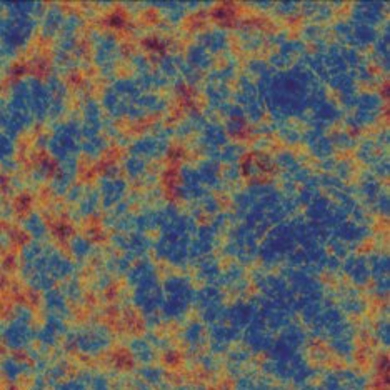
Ancient magnetic fields: What do they tell us about the early years of the universe?
NWO-subsidie image: Maarten Elion
Are magnetic fields older than the first light? And how did they influence the development of our universe right after the Big Bang? Cosmologists from Leiden, Groningen, and Utrecht are now collaborating to investigate this.
‘We don’t yet know much about large-scale magnetic fields, other than that they exist. What’s remarkable is that they have even been around black holes and in so-called voids – the vast empty spaces that contain almost no galaxies,’ says cosmologist Matthieu Schaller, speaking enthusiastically. ‘It’s precisely because they exist in these places too that we suspect magnetic fields may have already existed in the period immediately after the Big Bang, 13.8 billion years ago.’
The big question is: are these magnetic fields older than the very first light? During this period – the early universe – it was extremely hot, and all processes occurred in close proximity. ‘A large fraction of the knowledge we have about the formation of our universe begins at the moment the first light was emitted, about 380,000 years after the Big Bang,’ explains Schaller.
‘Magnetic fields may contain a wealth of information about those first 380,000 years. This new knowledge could have profound implications for both particle physics and cosmology.’
Dutch Magnetic Universe Consortium
‘We have succeeded in gathering all the expertise necessary to conduct this groundbreaking research,’ says Schaller. The project has been made possible by a grant from the NWO Open Competition XL (2023-2024), and in total, 19 researchers will be involved, including ten PhD students and postdocs, spread across three universities and the Nikhef Institute. Schaller adds, ‘It’s fantastic to be part of this.’
Leiden professor Ana Achúcarro brings extensive knowledge of the early universe. ‘It’s my specialty to create computer models that describe the evolution of the universe,’ explains Schaller. Thanks to project leader and professor Alexey Boyarsky, the group has a strong connection with the Cherenkov Telescope Array. These telescopes, currently under construction in Chile and La Palma, will measure gamma-ray radiation from cosmic sources such as black holes, neutron stars, or supernova explosions. Indirectly, this will provide new clues about the presence, shape, and strength of magnetic fields in the universe.
From the Big Bang to now
In the coming years, this group of scientists will design a series of new theoretical models that describe the generation and evolution of the very first magnetic fields. Schaller excitedly explains, ‘Among these models, there might be one that produces the correct calculations, but how do you find out which one it is?’

A powerful computer will process all the models, from the Big Bang to the present day. If one of the models gives a good prediction for the Cherenkov telescope data and of the current shapes and distribution of galaxies in 2025 – as measured by the Euclid space telescope – then they’ll know they’re on the right track. ‘On the other hand, in many cases, the models will likely produce a result very different from our reality. That’s when you know you need to improve your model,’ Schaller adds.
Cosmologist Subodh Patil, who is also involved in the project, will finally check whether the models and new theories still align with current theories of the early universe, as understood through gravity and light. ‘He ensures that we don’t let our imagination run too wild,’ summarises Schaller.

New laws of physics and applications on the horizon
Schaller predicts: ‘The core of this project is that we’ll learn more about the origin of our world, our universe. But we also believe this research will lead to new laws of physics. In a similar way, new insights in particle physics once led to the discovery of MRI scanners. People around the world benefit from those today. Similarly, research into large magnetic fields will lead to new applications – we just don’t know what they are yet.’
